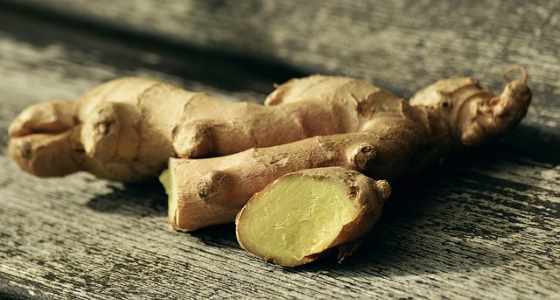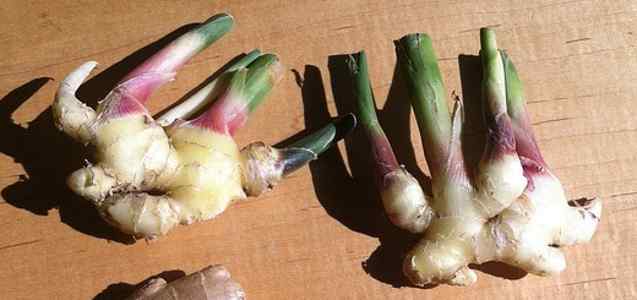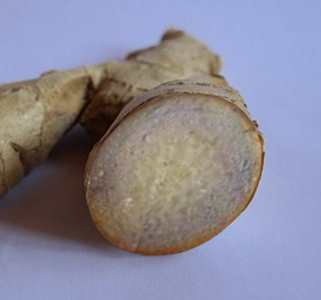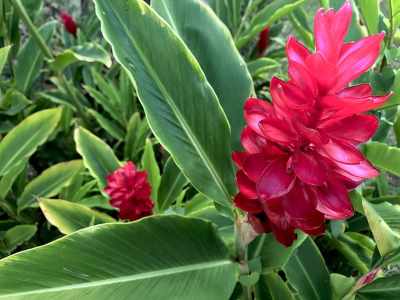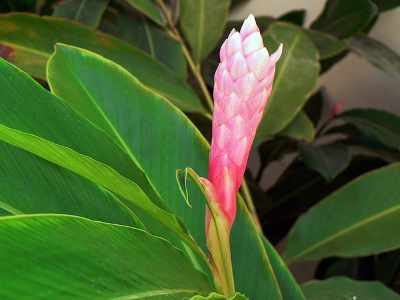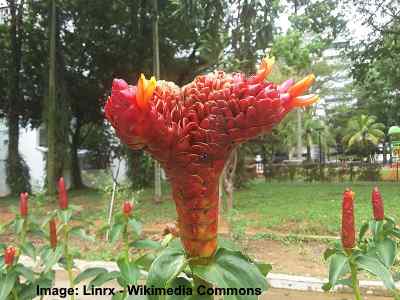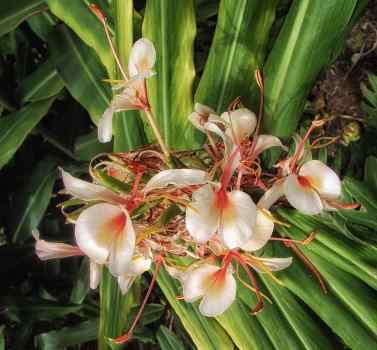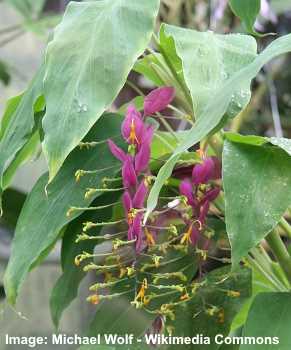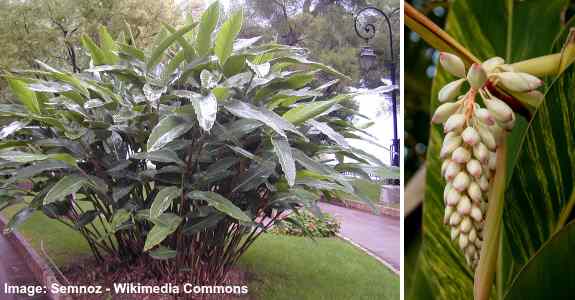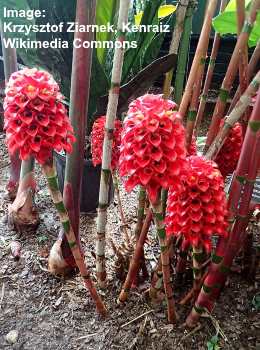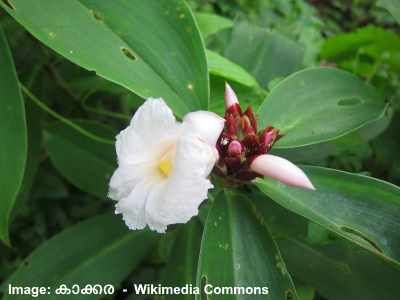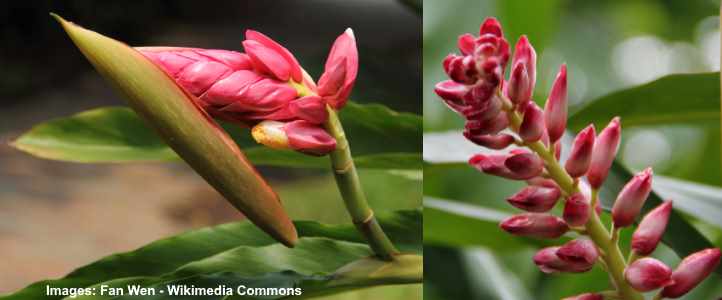Types of Ginger Root and Ornamental Ginger Plants (Including Pictures)
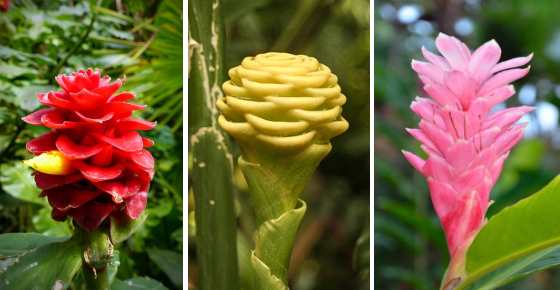
Most people think of ginger as an edible spicy root but ginger is also a beautiful type of ornamental flowering plant. Ginger flowers come in various colors, shapes, and sizes. Some types of ornamental ginger plants have red, pink, yellow, white, or orange flowers. Flowering ginger plants can look like shells, clusters of flowers in the shape of cones, or like small lily flowers.
Of course, most people think of ginger as the spicy root. Common yellow ginger has many health benefits and can help to spice up a meal. You can grate ginger root to make tea, slice it and add it to stir-fries, or take dried ginger root supplements.
However, if you want to add color to your garden, then you should use ornamental ginger plants. Some parts of ornamental ginger varieties may be edible. You may even find some types of ginger plants that are good for your garden or for growing indoors.
Before you think about adding ornamental ginger to your garden display, it is important to know that ginger is a sub-tropical plant. So, it may not grow in all climates. In this article, you will also find an interesting short guide to growing ornamental ginger flowers.
Let’s look at different types of ginger root as well as the unique characteristics of each type of ginger plant that flowers.
Common Types of Ginger Root (With Pictures and Names)
All types of ginger are flowering perennial plants. Some have long stems and thin leaves whereas others have large wide tropical-type leaves. Even ginger that is grown for its edible roots is a type of flowering plant. However, edible ginger root is usually harvested before the plant produces flowers.
First of all, let’s look at the types of ginger that most of us are familiar with – ginger root.
Yellow Ginger Root
Yellow ginger root is the rhizome (stem-root) of the common ginger plant (Zingiber officinale). Ginger is a perennial plant of the Zingiberaceae family and there are many species in this group.
Ginger root is a thick fibrous rhizome that clumps together and stems out in various directions. In fact, the name “ginger” comes from the Sanskrit word for ‘horn-root.’
The yellow ginger root is covered by a thin brown skin that can be scraped or peeled before consumption.
On average, common ginger rhizomes grow between 1” and 6” (2.5 – 15 cm) long. The ginger plant also produces stems with leaves on it that can grow from 3 to 4 ft. (around 1 meter) tall. Depending on the maturity of the ginger root, it may be juicy and fleshy. Older yellow ginger root is drier and stringy.
Fresh ginger root has a strong aroma and spicy pungent taste.
Baby Ginger
As its name suggests, baby ginger is just a younger version of common ginger root. This type of edible ginger has a white color and the rhizomes are not as fibrous.
One of the differences between baby ginger and mature ginger root is the taste. Baby ginger is a much milder and less pungent than yellow ginger. It is also the freshest type of ginger you can buy. In fact, it is so fresh that you may be able to buy baby ginger with the stalks still attached.
The mild ginger taste of baby ginger makes this variety great for pickling or adding to stir-fries.
Blue Hawaiian Ginger
Blue Hawaiian ginger root is an edible type of ginger that has a blueish tinge through the rhizome.
When in its immature state, the roots of blue ginger look just like any kind of ginger plant. As the rhizomes mature, they take on distinct blue and purple hues. As with all types of edible ginger, Blue Hawaiian ginger intensifies in flavor and pungency as it matures.
This blue ginger variety is a cross between Hawaiian yellow ginger root and a species of Indian ginger.
Types of Flowering Ginger (Ornamental Ginger Plants)
Flowering ginger ornamental plants are prized by gardeners in tropical and sub-tropical climates. Before looking at the many types of ginger plants that flower, let’s look at how to grow flowering ginger.
Growing Ginger Plants that Flower
Ornamental ginger plants need constant warm temperatures and humid conditions to produce flowers.
For ginger to mature and flower, it needs to be in temperatures of at least 50°F (10°C) for 10 months of the year. From this time, you need several months where the temperature is always above 70°F (21°C) This allows the ginger rhizomes to mature and produce flowers.
Another factor to consider when growing flowering ginger is the time it takes to flower. Sometimes, it can take up to 3 years from planting rhizomes of flowering ginger until it blooms.
If you live in cooler climates, you can still try growing ginger. You should plant types of flowering ginger rhizomes in large containers. Take them indoors when the temperature drops to prevent the rhizomes from becoming dormant.
Let’s look in more detail at the many beautiful and interesting types of ornamental ginger plants that produce flowers.
Beehive Ginger
Ornamental flowering Beehive ginger (Zingiber spectabilis) is a stunning example of a ginger plant that flowers.
Beehive ginger plants have stems that grow to about 6 ft. (1.8 m) in height. When this ginger flowers, large flower-like bracts appear. Bracts are modified leaves that form a colorful type of cluster that looks like a flower. Often, the bracts on ginger plants are far more stunning than the flowers they produce.
The cone-shaped bracts of Beehive ginger can be in various shades of red or brown. Some Beehive ginger cultivars produce “flowers” in yellow, gold and pink. Because of its shape, this ginger plant is also called ‘pine cone ginger.’
As long as you live in warm, humid climates this species of flowering ginger is easy to grow outdoors. This ginger variety needs a lot of sun to flower. However, too much direct sunlight can burn the leaves and affect the plant’s health.
These ginger flowers also make good cut flowers as their color and shape hold up well.
Red Ginger
The ornamental ginger species called Red Ginger (Alpinia purpurata) produces striking vivid red or pink cone-like flowers (bracts).
The stems of the Red ginger plant grow to a height of about 6 ft. (1.8 m). Its leaves are long and much wider than other ginger plant species. The blooms of Red ginger are showy displays of red or pink plumes that are in the shape of a cone. On top of these colorful bracts are dainty white ginger flowers.
Red ginger grows outside in warm places such as the Caribbean, South Florida, and islands in the Pacific Ocean. The ginger plant thrives in partial sun and moist, humid conditions.
You can also grow this ginger species for its flowers indoors or in greenhouses. The large showy “flowers” look stunning in flower arrangements.
Indian Head Ginger
Indian Head ginger (Costus spicatus) is an ornamental ginger plant from the Costaceae family. This is another example of a kind of flowering ginger that has red blooming flowers.
This ginger plant with red flower grows up to 7 ft. (2.1 m) high. It has large wide leaves that can measure 12” (30 cm) long and 4” (10 cm) wide. When it flowers, large cone-shaped bracts emerge from the stem that are generally a fiery reddish-orange color.
As with most varieties of flowering ginger, Indian Head ginger doesn’t tolerate frost. Warm, humid condition and full sun are needed for this species to bloom.
Torch Ginger
Native to Southeast Asia, the flowering Torch ginger (Etlingera elatior) is prized for its showy flowers with large red or pink petals.
This perennial ginger plant is also called the ‘Ginger flower,’ ‘Torch lily,’ ‘Wild ginger,’ or ‘Porcelain rose.’ The flower of this ginger plant has a tight cluster of pink to red petals that form an egg shape in the middle. From this, long beautiful petals spread out to form a star.
Unlike many other types of ornamental ginger, this flowering variety prefers full to partial shade to grow. However, warm, humid conditions are a must and, therefore, this is a true tropical type of ginger.
Although pink flowers are the most common type on this ginger plant, red and white are also popular.
Many parts of this ginger plant are used in Asian cuisine. Some people add the flower buds to chili sauce, stewed fish or to make a Thai salad.
White Ginger Lily
This Indian variety of flowering ginger, the White Ginger Lily (Hedychium coronarium) has beautiful white flowers that look like jasmine. White Ginger Lily is also grown in Hawaii for its ornamental value and in China for its medicinal properties.
This perennial flowering plant prefers to grow in damp conditions such as rain forests and near streams. The rhizomes spread quickly and are considered invasive in some countries. However, the beauty of this white ginger variety is due to its flowers.
Delicate white flowers appear on the tops of long stems. These have a strong fragrance and butterfly shape. Another feature of the White Ginger Lily is its long elongated dark-green oval leaves. These leaves can measure about a foot long (30 cm) and 4” (10 cm) wide.
Globba Ginger
There are about 100 species of flowering ornamental ginger plants in the Globba genus. Flowers ginger plants from the Globba family are some of the most interesting of all the ginger varieties.
Globba ginger plant flowers are clusters of small flowers that hang down from the bracts. These flowers of varying colors are in the shape of a hook. The flower-like bracts can be stunning displays that droop down from the short stems. The showy bracts can be various shades of color from purple to white.
One of the most popular Globba cultivars is the Dancing Lady Ginger (Globba winitii). This exotic tropical ginger plant has mauve bracts with long stems and tiny tubular yellow flowers on them. The flowering period of this ginger plant can last up to a month.
Globba ginger flowers also make good floral arrangements as they can stay fresh for up to 14 days after cutting.
Shell Ginger
Another ornamental ginger from the Alpinia genus is the Shell Ginger (Alpinia zerumbet). This type of ginger plant is also called the ‘pink porcelain lily,’ ‘butterfly ginger,’ or ‘variegated ginger.’
This tropical evergreen perennial grows in tropical climates. It is a clumping type of flowering plant that can reach up to 10 ft. (3 m) tall. When this ginger plant blooms, it produces clusters of tiny funnel-like flowers that look like a shell before they open. The flower shells are generally a white to light pink color with yellow petals when they open.
You can also grow Shell ginger plants indoors if you want colorful delicate flowers and lush greenery in a room. In containers, this species of ginger plant will grow between 3 and 4 ft. (1 – 1.2 m).
As with many ornamental ginger plants, this species requires a lot of sun with partial shade. Conditions need to be warm and humid for the plant to thrive and flower.
Pineapple Ginger
The Pineapple Ginger (Tapeinochilos ananassae) is a tropical reed-like flowering plant. This flower-producing ginger plant has a large colorful pineapple-shaped bract on the end of short stems when it blooms.
When it grows in full sun, the Pineapple Ginger can grow between 6 and 8 ft. (1.8 – 2.4 m). The tropical flowers (bracts) on this ginger variety can reach a length of between 8” and 12” (20 – 30 cm).
Although the plant looks like a reed, it has dark green leaves that wrap around the stems.
This flowering ginger variety looks similar to other bract varieties such as Red ginger and Beehive ginger. The red, waxy bracts have beautiful white or yellow flowers inside them which only add to its exotic appearance.
Malay Ginger (Crepe Ginger)
One of the most beautiful types of ornamental ginger plants is the Malay Ginger (Costus speciosus). Due to its thin wavy flowers, this flowering ginger is also called the ‘Crepe ginger.’
Native to Malaysia, the Malay ginger grows well in warm humid climates. This species of ginger also grows and flowers well in Hawaii.
The stems on this ginger plant can grow up to 10 ft. (3 m) tall. When the plant flowers, reddish-purple bracts appear that form a conical shape. This group of bracts then produce stunning small white flowers with a faint yellow center.
Alpinia Ginger Flowering Plants (With Pictures and Names)
The largest number of species of flowering ginger plants are those in the Alpinia genus. Some of these types of flowering plants can grow to over 8 ft. (2.4 m) tall. Usually, the bracts on these ornamental types form a cone or spike shape that have small flowers.
Being a member of the ginger Zingiberaceae, these are aromatic plants that are rich in essential oils.
Apart from the flowering Red ginger and Shell ginger, other notable species in this genus include:
- Australian native ginger (Alpinia caerulea) with bobble-like blue capsules that contain white pulp. The leaves of this ginger plant are sometimes used in cooking instead of ginger root.
- Lesser galangal (Alpinia officinarum) has red and white flowers and an edible rhizome that is aromatic and spicy.
- Blue ginger (Alpinia galanga) is a reed-like ginger plant that flowers and produces red fruit. All parts of this type of ginger, including the root, are used in cooking.
- Dwarf cardamom (Alpinia nutans) is a type of bushy flowering ginger plant with long thin leaves. This ginger produces flowers that look like porcelain shells at the end of foot-long (30 cm) stalks.

